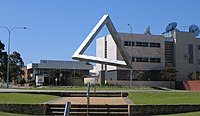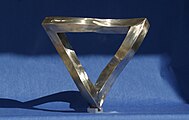Penrose triangle
The Penrose triangle , also known as the Tribar , is a so-called " impossible figure ". It shows three bars that seem to be at right angles to each other and yet are connected to form a triangle. This violates several laws of Euclidean geometry , including the one that says that the interior angle sum in a triangle is always 180 °. The viewer of a tribar representation is confronted with the difficulty of constantly having to reinterpret its distance to the parts of the tribar and their location in the space shown.
The invention of the tribar
The Tribar was invented in 1934 by the Swedish artist Oscar Reutersvärd , whose works, however, remained largely unknown to the public until the 1980s.
It was invented once again by the mathematician Roger Penrose , after whom it is also named. In 1954 he took part in the international mathematicians' congress in Amsterdam , on the occasion of which an exhibition was organized with pictures by the Dutch graphic artist MC Escher . Inspired by Escher's representations, he tried himself to design impossible figures. The principle of the impossible figures seemed to him most clearly realized in the Tribar. Together with his father, Lionel Penrose , who was inspired by his son's designs to design the infinite Penrose Staircase , he published an article on the Tribar in the British Journal of Psychology in 1958.
The tribar in art
Figures formed according to principles similar to that of the tribar have existed in art since the invention of perspective. One example is the “Carceri” by the Italian artist Giovanni Battista Piranesi , on which an architecture that is in part impossible is shown.
In the 20th century, Reutersvärd had been experimenting with depicting impossible figures, including those of the Tribar, since 1934. However, it wasn't until the 1980s that his work gained the attention of the masses. At that time, the Swedish Post also published three stamps with impossible objects from Reutersvärds, based on principles similar to that of the Tribar.
Escher was made aware of the Tribar by Penrose. He had already designed his picture "Belvedere" when Penrose sent him a copy of his article. This inspired him to his picture “Treppauf, Treppab”, in which he took over the infinite staircase from Lionel Penrose without major changes, and a little later to his picture “Wasserfall”, which shows the viewer a waterfall that feeds itself and its Representation based on the tribar.
Sculpture by Brian MacKay and Ahmad Abas in Perth , Australia.
Model from the “Treffpunkt Physik” association on a playground in Sankt Margareten im Rosental , Carinthia.
clear perspective at the German Museum of Technology in Berlin .
Is an impossible object like the tribar possible?
Penrose gives the simplest answer in his article: “Every single part of a figure is acceptable as a representation of an object that stands normally in space; however, accepting the entire object leads, as a result of incorrect connections between the individual parts, to the deceptive effect of an impossible structure. "
An impossible figure thus fulfills two conditions: 1. It consists of individual parts that are possible in the pictorial space without contradiction. 2. These parts are connected in a way that is possible on the two-dimensional picture surface, but impossible in the three-dimensional space shown.
For the explanation of such figures, the findings of Gestalt psychology play an important role, in particular that seeing is not a passive process, but always the active interpretation of what is seen, that the whole of perception is something other than the sum of its parts and that we are under the illusion can not withdraw, even if it represents something seemingly impossible.
See also
Web links
- impossible figures large collection
- Big Tribar in Austria "Physics at the Playground" in Gotschuchen / Southern Carinthia
- Video: Penrose's 'Impossible Triangle' . Institute for Scientific Film (IWF) 1983, made available by the Technical Information Library (TIB), doi : 10.3203 / IWF / K-143 .
Individual evidence
- ^ Sharpless Lionel Penrose, Roger Penrose: Impossible objects: A special type of visual illusion. In: British Journal of Psychology. Volume 49, No. 1, 1958, ISSN 0950-5652 , pp. 31-33, doi: 10.1111 / j.2044-8295.1958.tb00634.x .





